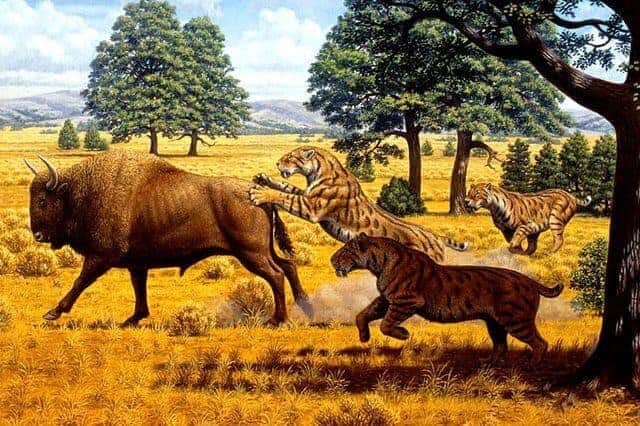Saber-toothed cats that roamed Los Angeles 12,000 years ago had many injuries to their shoulders and backbones that likely occurred when they killed large herbivore prey such as bison and horses, UCLA biologists report in the journal Nature Ecology and Evolution.
Their Southern California contemporary, the dire wolf, was more likely to suffer from injuries to the head, neck, ankles and wrists, the researchers report.
“The difference in neck injuries between the two animals is dramatic,” said lead author Caitlin Brown, a UCLA doctoral student in ecology and evolutionary biology. “The dire wolves had many neck injuries clustered together that could have resulted from the wolves being dragged by thrashing prey, as we see in modern wolves. In contrast, the saber-toothed cat has almost no neck or head injury, which implies that they were avoiding damage to their precious teeth.”
Brown and another UCLA doctoral student in ecology and evolutionary biology, Mairin Balisi, analyzed more than 35,000 bones from saber-toothed cats and dire wolves over six months at the La Brea Tar Pits’ George C. Page Museum. The researchers found injuries on 4.3 percent of all saber-toothed cat bones and 2.8 percent of all dire wolf bones.
Like modern gray wolves, dire wolves — which “are not made-up beasts for ‘Game of Thrones,’” Brown said — were predators that caught and killed prey with their jaws. By contrast, saber-toothed cats (Smilodon fatalis), a species without close modern descendants, are thought to have ambushed large prey using powerful back and forelimb muscles to pull down and position the animals for killing bites. Saber-toothed cats were heavier than dire wolves, and are believed to have used their large forelimbs to pin down their prey.
“Consequently, we expected injuries in saber-toothed cats would likely be concentrated in the shoulder, anterior ribcage and spine, while those of dire wolves were likely to be more evenly distributed across all four limbs,” said senior author Blaire Van Valkenburgh, a UCLA professor of ecology and evolutionary biology. “In addition, head injuries were likely to be more common in the dire wolves because they were at risk of being kicked while biting the hindquarters during a chase. Caitlin and Mairin’s analyses supported these conclusions.”
While previous studies of these animals have demonstrated that injuries likely occurred during fierce battles, the UCLA biologists are the first scientists to study enough bones to determine how frequently the injuries occurred.
The finding that saber-toothed cats sustained more frequent injuries than dire wolves suggests that the cats faced a much greater risk of injury over their lifetimes. It is thought that this is because the cats killed relatively larger prey and may have done so alone, rather than as part of a group. Instead of exhausting their prey through a long pursuit, the cats ambushed prey at a short distance and immobilized them using their massive forelimbs before killing the prey with precisely positioned bites, the researchers said.
“Dire wolves hunted in packs, which were essentially a running set of jaws,” Van Valkenburgh said. “They had to do everything with their mouths. So we expected to see injuries where they were kicked in the head, and maybe injuries in the limbs, either by being kicked or by tripping during a hunt.”
Saber-toothed cats are not tigers, Balisi noted, and are only distantly related to modern cats.
The biologists studied only trauma, injuries that likely resulted from hunting. This trauma included fractures that had healed, severe or chronic muscle strain, and osteoarthritis.
Christopher Shaw, the retired collections manager and a current research associate at the La Brea Tar Pits and Museum, is a co-author. The research was supported by the National Science Foundation (grant SGP-1237928).

